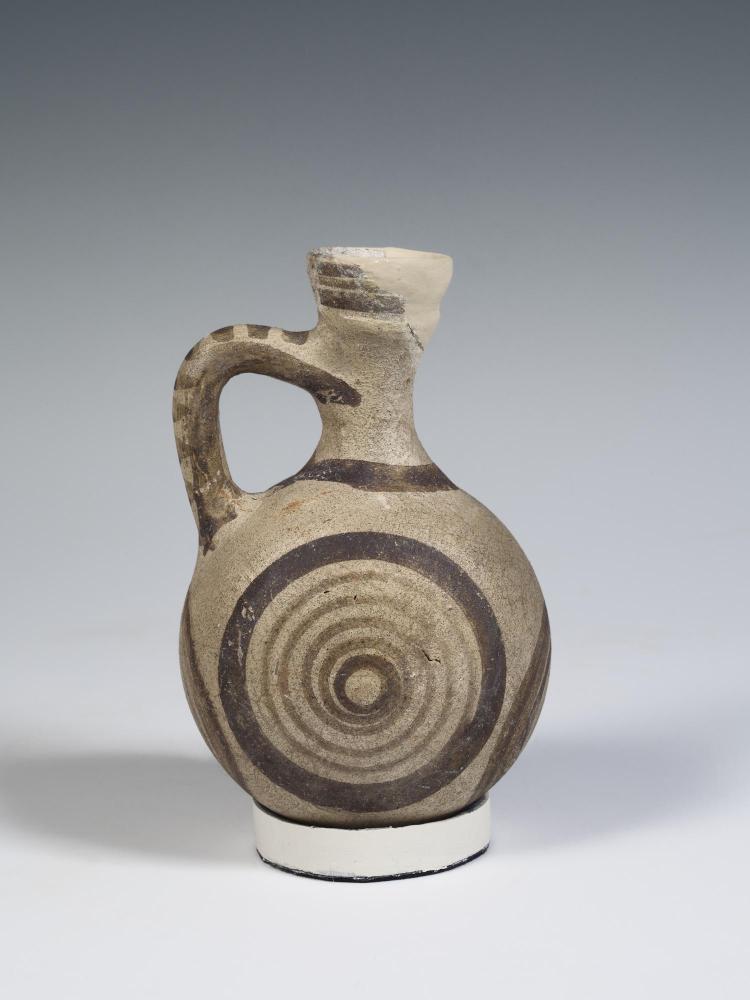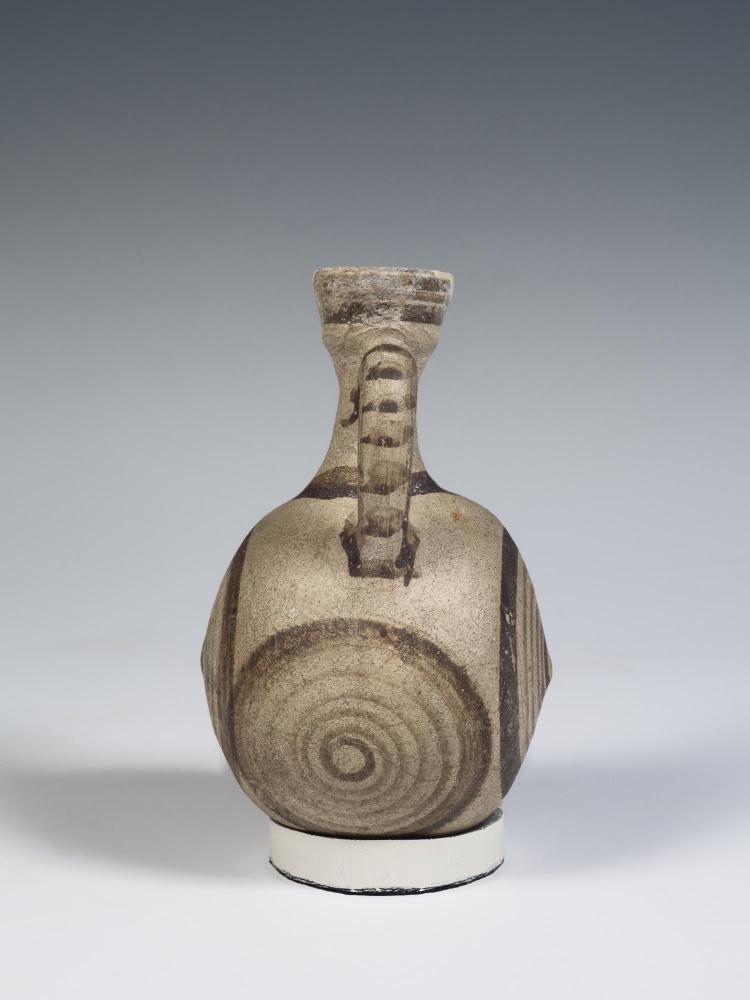2006.26.T, Cypriot Juglet
Catalogue Entry

This vase is one of a collection of Greek vases held by the CU Art Museum.
Gift to CU Classics Department
Transferred to CU Museum of Natural History
Transferred to CU Art Museum (2006)
Height: 10.8 cm
Diameter (max.): 7.0 cm
Date: c. 950-850 B.C.E.
Origin: Cyprus
Description: Small, roughly globular jug with rounded base, tall neck, and handle. Tan clay. Each of four sides of body has a closed spiral design, with thick outer circle and thinner, dilute brown spiral inside. One handle, decorated with horizontal brown stripes, connects shoulder to middle of neck. Thick brown line encircles base of neck. Lip and mouth decorated in brown.
Additional photos of this vessel show details of its mouth and decorative details.
Discussion
This small jug was created on the island of Cyprus and, based on the shape of the neck and lip (1) and comparisons with other pottery (2), dates to the Early Iron Age, approximately 950-850 B.C.E. (3).
The jug has a mostly spherical, but subtly barrel-shaped body, which flattens slightly on either side of the handle and protruding to form small nubs. This shape is similar to, but not as exaggerated as, so-called barrel-jugs from Cyprus, which were popular throughout the Early Iron Age (4). This just has a tall neck and a handle that connects the shoulder to the middle of the neck. The vessel is made of a pale buff-colored clay

Judging from its diminutive size and narrow neck with a small mouth, this jug was likely used for storing oil or some other valuable liquid. If so, this jug may have had a function similar to other vessel shapes, including the alabastron, the aryballos, and the lekythos, each of which is represented by at least one vessel in the CU Art Museum's collection. Due primarily to the island's location and its natural resources, the cultures of Cyprus were shaped by foreign influences. One of the largest influences on Cypriot culture was that of the Bronze Age Mycenaeans of mainland Greece. Through the influence of imported Mycenaean wares and interactions between local and foreign potters around 1400 B.C.E. (5), Mycenaean decorating motifs became integrated into local Cypriot styles and continued to influence decorated pottery for centuries afterward (6). This jug, then, reflects both the local traditions of Cyprus and Mycenaean influence. The shape itself, although rather generic, probably evolved from earlier local Cypriot wares (7). The painted decorations, however, show marked Mycenaean influence: the closed spiral is a favored Mycenaean motif representing waves (8) and never occurred in Cypriot pottery before the Late Bronze Age (c. 1,600-1,050 B.C.E.). The bars on the handle are a common decorative motif, appearing on both pre-1,600 B.C.E. Cypriot pottery as well as on Mycenaean vessels (9).
Collections of Cypriot Antiquities Online:
- The Cesnola Collection at the Metropolitan Museum of Art in New York
- The Belcher Collection at the Institute of Cypriot Studies at SUNY Albany in New York
Footnotes
- Andreas Demetriou, Cypro-Aegean Relations in the Early Iron Age (Cyprus: Zavallis Litho Ltd., 1989): 34; pl. 113.
- For examples of similar vases, see A. H. Smith and F. N. Pryce, Corpus Vasorum Antiquorum: Great Britain Fasc. 2, British Museum ii (London: Trustess of the British Museum, 1926): Pl. 11.
- Demetriou, Cypro-Aegean Relations in the Early Iron Age: 1.
- Demetriou, Cypro-Aegean Relations in the Early Iron Age: 34-35.
- A. D. Lacy, Greek Pottery in the Bronze Age (London: Methuen & Co. Ltd., 1967): 167-168.
- Vassos Karageorghis, Cyprus from the Stone Age to the Romans (London: Thames and Hudson Ltd., 1982): 77-79.
- Demetriou, Cypro-Aegean Relations in the Early Iron Age: 34-35.
- Lacy, Greek Pottery in the Bronze Age: 182.
- John Daniel, "Two Late Cypriote III Tombs from Kourion," American Journal of Archaeology Vol. 41 No. 1 (Jan. - Mar., 1937): 77-76.
Reference
- Chara Tzavella-Evjen, Greek and Roman Vases and Statuettes from the University of Colorado Collection (Athens: Archaiologikon Deltion, 1973): 192-197.

